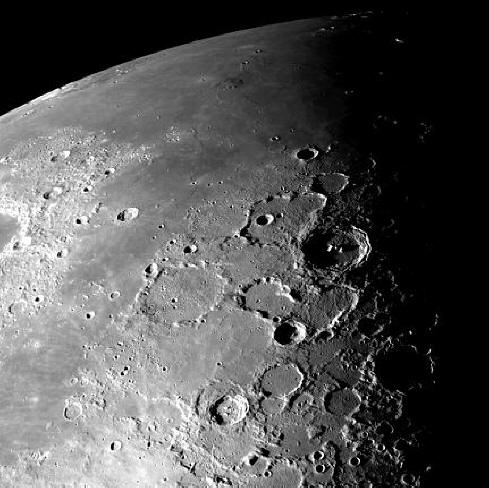|
|
Reconnoitering the Moon
Jun 19, 2009
New lunar
missions will look for water and
study the Moon's composition.
The Moon is about to be thumped. On
June 18, 2009 NASA launched the
LRO/LCROSS mission to look for
water on the Moon. Accomplishing the
task required that three separate
components launch together: a
Shepherding Spacecraft, a Centaur
rocket, and the Lunar Reconnaissance
Orbiter (LRO).
The LRO is designed to orbit the
Moon for a year, looking for
possible future landing sites and
analyzing the lunar environment with
a number of instruments, including a
high-resolution digital imager.
Since LRO will be in a polar orbit
only 50 kilometers high, it is hoped
that water might be found in the
deep craters located near both
poles.
LRO separated from the other two
spacecraft approximately one hour
after launch, with a scheduled lunar
orbital insertion on June 22, 2009.
The remaining two vehicles comprise
the Lunar CRater Observation and
Sensing Satellite (LCROSS), which
will arrive at the Moon much later.
The LCROSS Centaur rocket will first
be guided several times
around the Earth so that it can
pick up speed.
Each 38 day orbit, as they swing
past at a 90 degree attitude to the
Earth/Moon system, Earth will impart
a gravitational acceleration to
LCROSS until it reaches a velocity
greater than the bullet from a
hunting rifle. The Shepherding
Spacecraft will then separate from
the rocket, following it to its
planned intersection with the Moon.
The Centaur will impact the Moon,
where it is expected to blast out
subsurface compounds that NASA
scientists hope will contain water
ice.
On January 25, 1994, NASA
launched the Deep Space Program
Science Experiment satellite, also
known as
Clementine. Its primary mission
objective was to
map the Moon in visible and
ultraviolet light, so that the
various minerals that make up the
lunar regolith could be identified.
After the data was analyzed,
scientists announced that the south
pole of the Moon contained pockets
of water ice shielded from the Sun
by shadows cast from the walls of
deep craters.
The information sparked a renewed interest in lunar colonization because the
water ice could be a source of hydrogen, making it available for fuel and other
uses by potential human explorers. Water can be split into oxygen and hydrogen
with electricity, so solar panels could be transported to the Moon and used to
create breathable air and drinkable water, along with fuel for the return
journey.
At the time, some
researchers questioned the accuracy of
Clementine’s observations, or at least their interpretation. They suggested that
the instruments may have seen reflections off the steep sidewalls of the craters
and not ice deposits. Since the radar signature came from both brightly
illuminated and darkly shaded areas of Shackleton crater, specifically, the
reflection probably came from rocks and other debris rather than ice.
The LCROSS
Centaur has been aimed to hit the Moon near the north pole in this case, with
its Shepherding Satellite close behind. The Shepherding Satellite will fly the
same trajectory as the Centaur rocket, analyzing the explosion's debris plume
while plummeting toward the surface. After four minutes, the satellite will also
hit the Moon, raising its own plume of material. The LRO will make several
passes over the impact region, looking for the signature of volatile compounds
escaping from the craters left behind by its two companions.
The Japanese spacecraft Kaguya, whose two
year mission recently ended, found that the south pole craters contain no ice
after all. On September 14, 2007, the Japan Aerospace Exploration Agency (JAXA)
announced that the floor of Shackleton crater was –183° Celsius, but that
Kaguya's onboard Terrain Camera, with a 10 meter resolution, showed no bright,
highly reflective patches.
The researchers noted that the small excess of hydrogen ions recorded by
instruments on previous missions was most likely implanted in the regolith by
the solar wind. It is hoped that LRO/LCROSS will help to settle the issue.
As we have written in
past Picture of the Day articles, the
search for water on the Moon will most likely fail. The Moon was not formed by
innumerable strikes from high-velocity space rocks or thousands of comets out of
a hypothetical Oort Cloud. No water was brought to the Moon by millions of
cometary ice balls. The morphology of the Moon shows the signs of electric
discharge machining as we have argued many times. No water-bearing impactors
formed the terrain there. Rather, it was electricity that carved the Moon, and
any water that might have once existed there was dispersed into space by the energy released in
the events.
Stephen Smith
|
|
|
|
|
|
SPECIAL NOTE - **New Volumes Available:
We are pleased to announce a new
e-book series
THE UNIVERSE ELECTRIC. Available now, the first volume
of this series, titled Big Bang, summarizes the failure of modern cosmology
and offers a new electrical perspective on the cosmos. At
over 200 pages, and
designed for broadest public appeal, it combines spectacular
full-color graphics with lean and readily understandable
text.
**Then second and third volumes in the series are now available,
respectively titled Sun and Comet, they offer
the reader easy to understand explanations of how and why these bodies
exist within an Electric Universe.
High school and college students--and teachers in
numerous fields--will love these books. So will a large
audience of general readers.
Visitors to the Thunderbolts.info site have often
wondered whether they could fully appreciate the Electric
Universe without further formal education. The answer is
given by these exquisitely designed books. Readers from
virtually all backgrounds and education levels will find them
easy to comprehend, from start to finish.
For the Thunderbolts Project, this series is a milestone.
Please see for yourself by checking out the new
Thunderbolts Project website, our leading edge in
reaching new markets globally.
Please visit our
Forum
|
|
|
|
|
|
|
|







